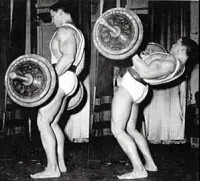From English the word cheating — "cheating" literally translated as “deception”, “fraud”, “scam”, “violation”.
That is cheating in bodybuilding and fitness - this is performing an exercise incorrectly, with violations, “not cleanly”, using some tricks and tricks to help yourself cope with the task.
Let's try explain with an example: Consider the exercise “pull-ups while hanging on a bar.” So, we all know this exercise and have done it many times. Let us illustrate the operation of the cheating principle. Let us consider two methods of performing this exercise:
- You can hang freely and, without swinging, slowly bend your arms, using your back muscles and biceps to pull your body with your chin to the bar.
- Or you can sharply lean forward, and then, moving backwards by inertia, do the same thing, but spending much less effort. In this version, we will be helped by swinging and some knowledge of the laws of physics.
The use of all sorts of tricks similar to the second point in fitness and bodybuilding is the use of the “cheating” principle.
But here's the question:
Is cheating harmful or beneficial?
There is no clear answer to this question, since sometimes cheating is needed, and can really help, and sometimes it’s harmful and you need to try to exclude it from your training as much as possible.
Cheating in bodybuilding and fitness should be used not as a tool to reduce the load on the target muscle, but on the contrary, as a mechanism for its increase. The main goal of bodybuilding is to stimulate the muscles to work harder and harder, and not to make life easier for them. As a result, you need to use the “cheating” principle only for the purpose of completing a few extra reps or as help involved muscles by engaging free muscles another part of the body. For example, you do a concentrated dumbbell lift while sitting on the biceps, and are no longer able to technically correctly complete the last couple of repetitions. If you use your other hand to help the loaded arm squeeze out a few extra final reps, this is a valid, intelligent application of the training principle of cheating. In another case, if you lift the “fifth point” from the bench, trying to squeeze out a few extra repetitions on the bench press, then this will be an unreasonable application of the “cheating” principle. The first example increases the load on the muscle, and the second decreases it.
For example, you are doing a standing biceps curl with a 40 kg barbell. Before this, you successfully progressed and added half, half, or a whole kilogram to this exercise every week. And then suddenly - a “dead point”. Stagnation. You have been doing 40 kg in this exercise purely and technically correctly for the second week now, and you just can’t get off this weight and add more load... In this situation, cheating can help you. Add weight to the bar. Naturally, you will not be able to do the required number of repetitions technically correctly, but using cheating (in this case, using your back and swinging your body) you will succeed! And, using this principle, having completed a couple of workouts with a new weight in this exercise, in the future you will definitely be able to do a full-fledged clean approach without any deceptions or tricks. This means that the “dead point” will be left behind, and you will continue your progress in this direction..
I hope, using the example of this article, you were able to understand how important it is to understand training principles fitness and bodybuilding in order to competently adopt them and use them where it is really necessary...
Post Views: 144


